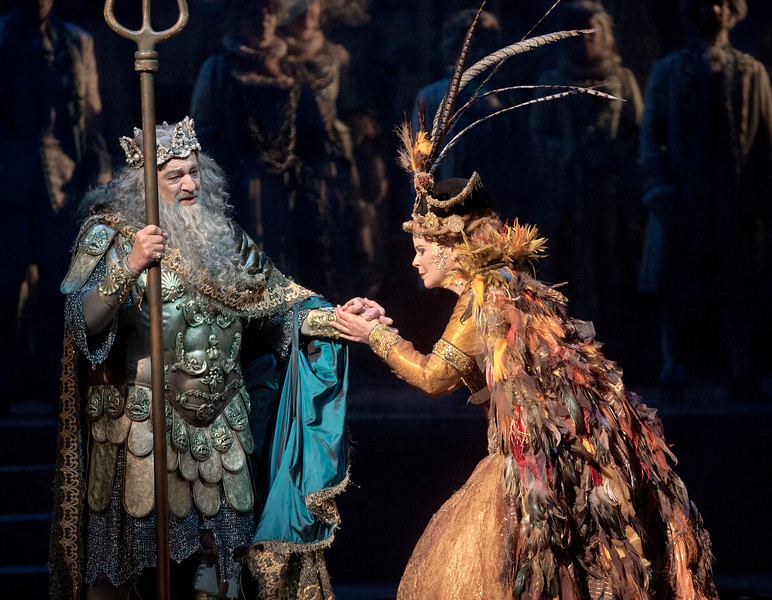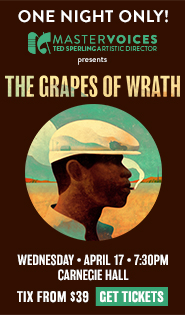With new cast members Met’s Baroque “Island” pastiche still enchants

Plácido Domingo as Neptune and Susan Graham as Sycorax in the Met’s “The Enchanted Island.”
Photo: Ken Howard
A hit for the Metropolitan Opera when it premiered on New Year’s Eve 2011, the nouveau-pastiche opera The Enchanted Island had its first revival on February 26. Aside from a few significant changes, much of the original cast returned, but the overlong production was mercifully trimmed by about ten minutes, and the first-act curtain moved to an earlier and more appropriate point in the proceedings. Additionally, in the tradition of the pastiche operas that The Enchanted Island pays homage to, two of its original arias were exchanged for others. A Vivaldi aria for the witch Sycorax has been replaced with “Sta nell’ircana” from Handel’s Alcina, and the Rameau aria that Plácido Domingo sang in 2011 in the second act has now been substituted with “Empio, per farti guerra,” from Handel’s Tamerlano.
The Met took a big chance on this “Baroque Fantasy,” which combines The Tempest and A Midsummer Night’s Dream as its point of departure. Devised and written by Jeremy Sams, and realized by the directing/designing team of Phelim McDermott and Julian Crouch (there is no specific director credit), it has always been an unwieldy three-hours-plus work containing a single intermission. On February 26 there was a good deal of audience attrition for the second act, but despite its longueurs, this remains an amusing and quite charming production, a visual spectacular that serves as a showcase for some very fine singing. It also includes some of the wittiest, most imaginative use of animated video projections yet seen on the Met stage, courtesy of 59 Productions.
William Christie brought Baroque authenticity to the score in 2011; this time he was replaced by Patrick Summers, who conducted with sensitivity and a fine feeling of support for the singers. It cannot be easy conducting in a manner that lends unity to a score that comprises the work of eight different composers. (For the record, they are: Handel, Vivaldi, Rameau, Campra, Leclair, Purcell, Rebel, and Ferrandini.)
David Daniels reprised the part of Prospero; although his voice has lost some of its original luscious sheen over the years, his lovely phrasing, control, and stage presence still keep him in the front ranks of countertenors. Their younger generation was represented by Anthony Roth Costanzo, again in the role of Ferdinand, who does not make his entrance until three-quarters of the way through the opera but immediately launches into a show-stopping aria. Roth’s light tone and long-breathed mezza-voce lines wove a spell that brought on a huge ovation.
Luca Pisaroni repeated his endearing, cartoonish Caliban; his big basso is ideal for the role, and, despite his light Italian accent, he displayed English-language diction that was so clear one rarely needed to check the seatback titling system. Danielle De Niese’s Ariel may have seemed overplayed to some, but she got her fair share of laughs, and she made the most of her ornate, showy arias, with her rapid staccato runs a particular standout.
Andriana Chuchman, the Canadian lyric soprano who made a successful last-minute debut earlier this season substituting for Anna Netrebko in L’Elisir d’amore, was a lovely Miranda with a pliant, flexible timbre. Standouts among the quartet of refugee lovers from A Midsummer Night’s Dream were rich-voiced mezzo Elizabeth DeShong as Hermia and the warm, mezzo-sounding soprano Janai Brugger. Andrew Stenson as Demetrius and Nicholas Pallesen as Lysander (in his house debut) performed with plenty of energy.
In the supporting role of Neptune, Plácido Domingo sang with his usual clarion force, but his thick accent made his English words unintelligible. He also seemed so buried under his heavy costume, wig, and beard that he had a hard time projecting the humor inherent in the character.
In 2011, Joyce Di Donato created the role of the witch Sycorax; this time it was taken by Susan Graham. Adept at comedy, Graham fit the character well, though her plush lyric voice seemed better suited to Act Two, when the witch loses her bag-lady look and transforms into a more glamorous creature. Graham is not usually thought of as a Baroque singer, yet she handled the vocal ornamentation with ease.
The Enchanted Island has turned out to be one of Peter Gelb’s more inspired ideas for the Met, and is likely to receive further revivals in the future. But next time around, Gelb might want to trim a little more off the top, so he he can bring Act One down to a more reasonable length. “Does this act ever end?” whispered my guest at one point. He fled at intermission.
The Enchanted Island runs through March 20. metoperafamily.org




Posted Feb 27, 2014 at 6:30 pm by BG Wheeler
Is the first act really all that long? 7:30 to 8:47? Your guest would have a had a much harder time with Prince Igor the night before, with two acts to follow the long prologue and first act, which end with that rather endless dance sequence.
It’s hard for me to imagine how anyone could not be riveted by this show. The singing, the greatest hits tuneful selections from the Baroque repertoire, the good acting and the wit. But then it’s hard for me to imagine leaving an opera before the end for any reason. I wonder what would hold the people who do that?